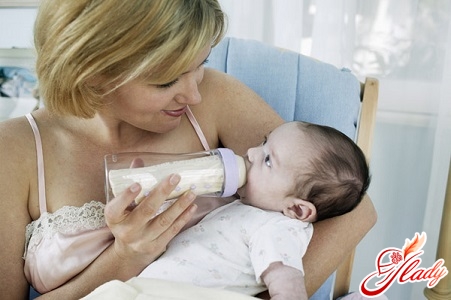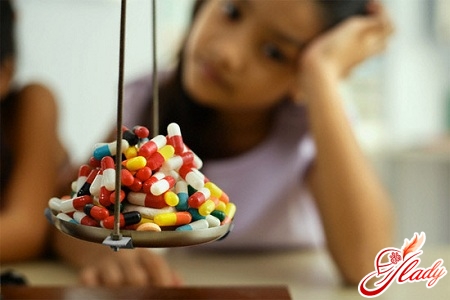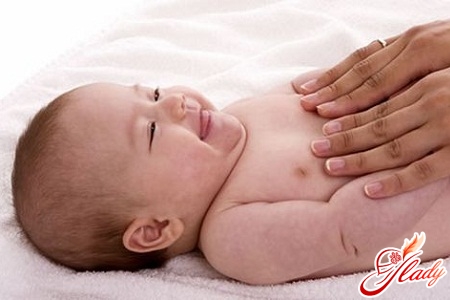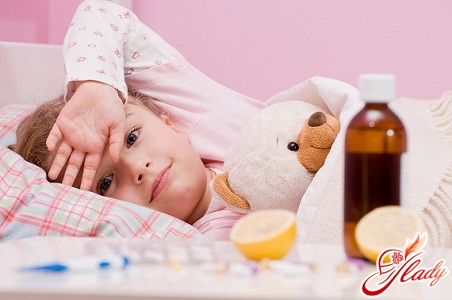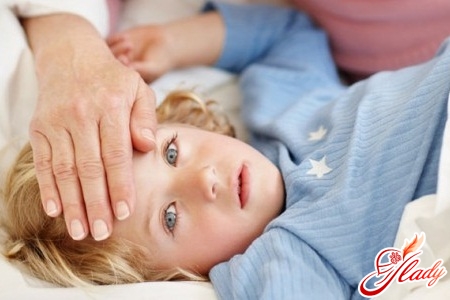 The baby has a high body temperature - headachepain and one of the main enemies of almost every young mother. As soon as she sees a figure on the thermometer that exceeds 37 degrees, the mother begins to panic and rush about - the baby is sick! How to bring down a child's temperature? However, do not rush and make premature conclusions. Pediatricians look at the problem of elevated body temperature in a baby a little differently. The main question for them is what exactly caused hyperthermia, and not what to give the child with a fever. Human body temperature is the most important indicator of the functioning of the body. Its maintenance at an optimal level, as well as the process of increasing it, depends on the work of the thermoregulation center located in the brain. The thermoregulation center is responsible for maintaining an optimal balance between the formation of heat in the human body and the process of heat transfer. A newborn child is born with an immature and, accordingly, imperfect thermoregulation system. As a result, the body of a newborn baby is not able to independently maintain a stable body temperature for the first few months after birth. A child reacts very strongly to any changes in the ambient temperature - both at home and outside during a walk. And the well-being of the baby largely depends on the parents - any error in proper care can lead to overheating or, on the contrary, hypothermia of the child. There is such a thing as transient fever. Doctors call transient fever a sudden increase in body temperature to 38 - 39 degrees. And such a condition is considered quite normal, because the baby, who finds himself outside the usual conditions of existence in the mother's body, is not able to control the thermoregulation of his own body. In the event that the child has a high temperature, the doctor may assume transient fever. But such a condition is short-term and lasts no more than 7 days - after this, such sharp changes in body temperature should no longer occur. The work of the thermoregulation system finally stabilizes at about three months of age. By this time, the child develops his own daily rhythms of body temperature. As a rule, in the morning the child's body temperature is slightly lower than in the evening and night hours.
The baby has a high body temperature - headachepain and one of the main enemies of almost every young mother. As soon as she sees a figure on the thermometer that exceeds 37 degrees, the mother begins to panic and rush about - the baby is sick! How to bring down a child's temperature? However, do not rush and make premature conclusions. Pediatricians look at the problem of elevated body temperature in a baby a little differently. The main question for them is what exactly caused hyperthermia, and not what to give the child with a fever. Human body temperature is the most important indicator of the functioning of the body. Its maintenance at an optimal level, as well as the process of increasing it, depends on the work of the thermoregulation center located in the brain. The thermoregulation center is responsible for maintaining an optimal balance between the formation of heat in the human body and the process of heat transfer. A newborn child is born with an immature and, accordingly, imperfect thermoregulation system. As a result, the body of a newborn baby is not able to independently maintain a stable body temperature for the first few months after birth. A child reacts very strongly to any changes in the ambient temperature - both at home and outside during a walk. And the well-being of the baby largely depends on the parents - any error in proper care can lead to overheating or, on the contrary, hypothermia of the child. There is such a thing as transient fever. Doctors call transient fever a sudden increase in body temperature to 38 - 39 degrees. And such a condition is considered quite normal, because the baby, who finds himself outside the usual conditions of existence in the mother's body, is not able to control the thermoregulation of his own body. In the event that the child has a high temperature, the doctor may assume transient fever. But such a condition is short-term and lasts no more than 7 days - after this, such sharp changes in body temperature should no longer occur. The work of the thermoregulation system finally stabilizes at about three months of age. By this time, the child develops his own daily rhythms of body temperature. As a rule, in the morning the child's body temperature is slightly lower than in the evening and night hours.
How correctly to measure temperature?
Very often parents ask doctors - pediatriciansthe question of how to measure body temperature correctly - in what place, with what thermometer, at what time? By the way, these questions make sense - since you need to be able to measure temperature correctly, without allowing for large errors. It is permissible to measure a child's temperature in the following places:
When measuring a child's body temperature, do not forgetmake an adjustment for the exact location where the measurement was taken. For example, in the armpit and groin fold, the thermometer readings will be higher by about 0.3 tenths than in the mouth.
Types of thermometers
Not so long ago, parents had at their disposalone - the only good old mercury thermometer. At that time, the question of which thermometer was better simply did not arise. Nowadays, there is such a large selection of thermometers that parents are faced with the question of which one is better.
- Infrared nipples - thermometers
In its appearance, such a thermometer is verystrongly resembles a regular pacifier. Just give it to your baby like a regular pacifier and take it away after the sound signal sounds. It would seem that such an option is very convenient. However, this method also has its drawbacks, the main one being the distortion of measurement data. They are explained very simply - the child sucks on the pacifier, while the friction force acts on it, which increases the thermometer readings.
- Temperature strips are indicators
These strips are glued to the baby's forehead and afterchange color in a few minutes. However, such strips are very inaccurate and can only serve as a preliminary assessment of the child's condition. But, as a rule, an attentive mother does not need these strips at all - they will determine the increase in body temperature of their baby with one touch.
- Electronic thermometers
In appearance, electronic thermometersresemble traditional mercury ones. However, the main difference is that electronic thermometers use special sensors to determine body temperature instead of mercury. After measuring the temperature, the electronic thermometer gives a sound signal. However, by the way, pediatricians advise parents to measure the temperature with an electronic thermometer for five minutes, even if the signal sounds earlier. A huge plus is the safety and harmlessness of electronic thermometers.
- Mercury thermometer
Despite the huge selection of the most modernthermometers, the good old mercury thermometer does not give up its positions. And doctors, frankly speaking, prefer mercury thermometers, the readings of which are the most accurate. However, when using them on children of any age, parents should remember about safety precautions and in no case leave the child unattended while measuring body temperature.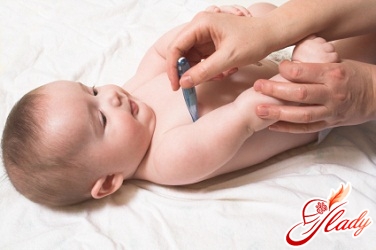
Temperature precursors
As mentioned above, experienced and attentiveA mother can almost always determine that her baby has a fever without a thermometer, and she only needs a thermometer to check the temperature. So, a child's fever can make itself known in the following ways:
- Violation of the central nervous system.
A sick baby may be lethargic and sleep constantly. Or, on the contrary, experience excessive excitement - be capricious, refuse the usual daily routine.
- Cold extremities.
In many children, when the temperature rises,the body immediately gets cold, the arms and legs. This very often simply panics parents. This condition is caused by the fact that the increase in body temperature is often caused by the fact that the child's still weak vascular system reacts to the increase in body temperature by spasming the vessels. As a result, the blood flows in smaller quantities and the child's arms and legs get cold. As a rule, such a reaction is typical for children under five or six years of age, or weakened.
- Increase in the frequency of respiratory movements.
When the baby's body temperature rises, breathing becomes shallow and frequent. Any attentive mother will definitely notice a change in the normal breathing rhythm.
Disease or ...?
As already mentioned, almost any mother,seeing even a slight increase in their child's body temperature on the thermometer, they mistakenly believe that the child has contracted some kind of infectious disease. Of course, these fears are often justified, and the temperature becomes a companion of an infectious disease. However, in addition to various viruses and bacterial agents, an increase in temperature can be caused by other reasons. And very often it is the parents who, in one way or another, provoke such temperature jumps.
- Too warm clothes.
For example, any mother, at least occasionally, butplays it safe and dresses her baby too warmly for a walk. And such an action can lead to overheating of the child, disruption of his thermoregulation and, as a result, an increase in body temperature. Hyperthermia, which is a consequence of such overheating, can persist for up to 48 hours.
- The temperature of the surrounding baby is too high.
Approximately the same mechanism of process disruptionthermoregulation also works if the child is exposed to direct sunlight for a long time or in a stuffy room. Therefore, in hot weather, doctors recommend walking in the morning and evening hours, avoiding crowded places, as well as saunas and baths.
- Excessive psychoemotional stress.
There is a popular concept called “shouted out”temperature". Doctors also confirm that this is quite possible. The child's body temperature may well rise above the norm if the child cried for a long time, or was under stress, for example, he had important exams or tests. Such cases of fever are quite common among high school students during graduation and entrance exams.
- Teething.
About the fact that teething is oftenaccompanied by an increase in body temperature, all parents without exception have heard. Some firmly believe in it, while others consider this information a relic of the past. However, pediatricians do not share either position. They believe that teething itself is not a pathological phenomenon that can lead to hyperthermia. However, teething often causes the development of an inflammatory process in the mucous membrane of the gums. But this inflammatory process can lead to the fact that the temperature of an infant can rise. But all these cases have one thing in common - the temperature rarely exceeds 38 degrees. But a higher temperature, alas, most often indicates the development of some disease in the baby. Hyperthermia accompanies almost all childhood diseases: chickenpox, measles, rubella, etc. In addition, almost all acute respiratory diseases in children are also accompanied by an increase in body temperature. Also, an elevated temperature in a child occurs with intestinal infections, ENT diseases and diseases of the respiratory system.
Why does the body temperature increase?
Many mothers continue to do so year after year.make the same mistake - as soon as they see a temperature above 37 degrees on the thermometer, they begin to try by hook or by crook to bring the temperature down to normal values. Mothers believe that by immediately bringing down the temperature, they will be able to prevent its further increase and the development of the disease. But in fact, this is absolutely not true. An elevated body temperature is not a disease, but only indicates that the child's body is fighting its immune system and foreign agents - bacteria, viruses. At an elevated body temperature, the active reproduction and growth of viruses and bacteria is suspended, some of the foreign agents die. In addition, an important fact is that at a body temperature above 39 degrees, the body begins to produce an antiviral protective substance called interferon, and also begins to produce immunoglobulins - proteins designed for the normal functioning of the immune system. Another misconception is the opinion that the level of temperature increase and the severity of the disease are closely related. However, in reality, this is absolutely not the case, especially in small children whose immune system does not yet function properly. And, accordingly, the reaction to the same disease in different children can be very different - for example, one child may have a runny nose with practically no increase in temperature, while another child's thermometer readings can reach 39 degrees. Doctors are especially concerned about cases in which such serious diseases as pneumonia, for example, occur without a temperature at all. That is why you should not rush to get pharmacological drugs and start bringing down the temperature. As a rule, doctors do not recommend trying to reduce the body temperature below 38.5 degrees. The exceptions are children under one year old and those babies who have previously had cases of febrile seizures.
Confusing temperature
But despite all the benefits of increasedtemperature, there is a certain line after which the temperature not only can, but also must be brought down. In the event that the thermometer has crossed 39, the work of the immune system, on the contrary, begins to be significantly suppressed, the load on the cardiovascular and respiratory systems increases significantly. In order to help the child and alleviate her condition, parents should know how to reduce the child's temperature quickly and safely. To reduce the temperature, doctors prescribe pharmacological drugs, the active ingredient is either ibuprofen or paracetamol. Such drugs for fever for children are sold in any pharmacy without a prescription. But such a favorite medicine for fever as aspirin or acetylsalicylic acid is categorically not recommended for children, since it has an extremely negative effect on the condition of the gastric mucosa. You should also not experiment with drugs that are previously unfamiliar to you, not approved by your doctor. In addition to the temperature, you do not want to get a number of other complications, do you? That is why a pediatrician should decide what to give a child with a fever. In addition to medications, do not forget about non-drug methods of reducing the temperature:
- Wipe off with water.
Just a few decades ago, people were veryrubbing with water and vinegar was popular. However, modern medicine has an extremely negative attitude towards this method of lowering the temperature. During hyperthermia, the child's pores expand significantly, and vinegar penetrates the child's body almost unhindered. As a result, poisoning may develop, and even disruption of the normal functioning of the kidneys. This is not the best solution for how to lower the temperature without medication. By the way, rubbing with vodka is unacceptable for the same reason - alcohol is very quickly absorbed through the pores expanded by the temperature, leading to general poisoning of the child's body with ethyl alcohol. It is much more effective and safer to rub the child with a cloth soaked in ordinary cool water. Wipe the baby's arms, tummy, back, not forgetting the armpits. It is necessary to wipe at least once an hour.
- Wraps.
If the baby's temperature rises above 39.5degrees, immediately call an ambulance, and before they arrive, completely undress the child and wrap him in a towel soaked in water at room temperature. Change the sheet as it warms up, until the ambulance arrives. However, in no case should you overdo it and do not wrap the child in a sheet soaked in too cold water. Monitor the drinking regime of the sick child. Lack of fluid in the body during hyperthermia has a very negative effect on the course of the disease and the well-being of the child. The recommended volume of liquid at elevated body temperature is at least 100 grams for each kilogram of the baby's weight. Liquid should be drunk in small portions, but often. It is best to give the child clean cool water or fruit drinks. Do not forget to regularly measure the body temperature of the sick child - at least once every two hours. This measure allows you to track the effectiveness of measures aimed at reducing the temperature. After all, if for some reason the antipyretic drug did not have the desired effect, it is necessary to look for other ways to reduce the temperature. In addition, based on the graph of body temperature changes, the doctor can more reliably judge the features of the course of the disease. In any case, an increase in body temperature in a child of any age serves as a signal for the need to seek medical help from a doctor. Only a doctor can really assess the entire picture of the disease, prescribe a treatment regimen, and, if necessary, send the child to the hospital. And most importantly, the doctor will prescribe the treatment that will eliminate not the temperature itself, but the cause of its increase, that is, the disease. We recommend reading:




